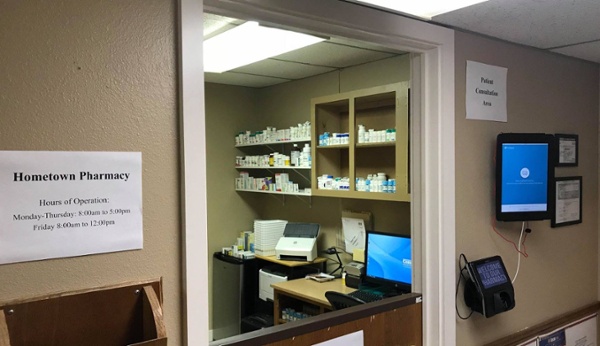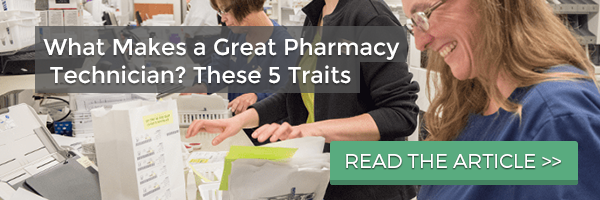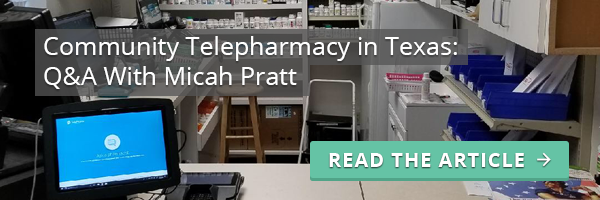“Before we opened the telepharmacy, if patients went to the clinic in Silverton they had to drive an hour to get their prescription,” said Brant Guthrie, RPh, Hometown Pharmacy.
“We put a telepharmacy in the clinic to make it much easier on patients.”
Brant facilitated the opening of a community telepharmacy inside of the Cogdell Clinic Briscoe County in Silverton, Texas on May 1, 2018. It is the first telepharmacy to open in the state of Texas outside of the state’s pilot project. Brant, the managing pharmacist, is located at the host pharmacy in Lockney, Texas, 32 miles away. From there, he will review medications and consult patients using safe and secure telepharmacy software.
We sat down with Brant to discuss his journey into opening a community telepharmacy, what’s most important to him as a Texas pharmacist and pharmacy manager, and the pharmaceutical services he provides in his telepharmacy.

Can you tell us the story of how you became a pharmacist?
“Growing up, both of my parents were registered nurses so I grew up around the medical field,” said Brant, reminiscing on his childhood.
“I went to work with my mom every now and then. I got to see that part of it and that’s where my interest was sparked. Around junior high I knew I wanted to be a pharmacist. I was always interested in science and math, and then I got accepted to Texas Tech. Personally, my biggest passion was always to be in a small town pharmacy. I always wanted to spend time with patients and really help people. Community pharmacy is where I’m at now and I love it.”
What prompted your journey into opening a telepharmacy?
“I didn’t have any idea about telepharmacy at first,” he said. “I heard about the pilot telepharmacy that was in Olton, Texas and I was excited. I thought it was a great way for an independent pharmacist to serve small communities that don’t have access to health care providers.”
“I started exploring the idea and asked myself: ‘Is this something we could do?’ They had a clinic in Silverton, TX and I thought it would be perfect to have a telepharmacy there. As soon as Texas passed regulations we went for it right away. We were the first to actually go through the telepharmacy application process and we helped the state create that process. It was a lot of work, but it’s been great, especially when I realize how many patients will be helped from our efforts.”
Was it a good experience?
“Yeah, absolutely. People were all excited when they heard about it; these communities really want access to a pharmacist. Before we opened the telepharmacy in Silverton, if they went to the clinic in town they had to drive an hour to get their prescription after their appointment. We put a telepharmacy in the clinic to make it much easier on patients.”
“A lot of these people were already our customers that we had been mailing to,” said Brant, discussing the convenience of the telepharmacy. “Patients were able to start their medications sooner, adherence improved, and patients were getting well faster. This was a win-win for everyone involved”
“Even people in Lockney (the host pharmacy) were giving us a lot of support for the Silverton telepharmacy.”
What is a misconception about telepharmacy that you overcame once you opened the Silverton telepharmacy?
“Trying to get people to understand it’s a standalone pharmacy, just like a normal pharmacy location,” he said. “Even though nothing is different in a telepharmacy other than the technician being supervised remotely, people thought they had to go to that specific clinic in order to go to the telepharmacy. We are still trying to get the message out that people can go to this location just like a normal traditional pharmacy and get the same quality of care they would at our store in Lockney.”
“Some of our patients are hesitant to use the technology at first. It’s all about customer service. We work with them and they begin to trust us over time. We explain to them that it’s not hard and Holley, the technician, will help them. And to be completely honest, it’s easy. All you need to do it look at the screen and talk to me. Once they try it they love it.”
What has been the experience of customers who previously lacked convenient access to medications? How has your business played a role in closing the gap in access and care in your community?
“We were mailing medications to a lot of these customers prior to opening the telepharmacy. Since we were mailing I never had the chance to actually talk to them. One great thing about going to the telepharmacy is I can look at the patient’s medication history, allergies, and take a little more time to work with that patient. It’s interesting we have allowed mailing of prescriptions for so long in Texas, but we are just now allowing telepharmacy. I’ve never been able to take the time to talk to these remote folks. Now that they come into the telepharmacy I’m able to do that and counsel them a lot better. I can even now help them select over the counter (OTC) products. I’ve had a lot of people say thank you so much for being here.”
Do people object to the technician being the lead in the building instead of the pharmacist?
“No. No issues with that. If you have the right technician in place, and we’ve all had a great technician who can handle this, there won’t be any objections.”
What services are available to patients in the Silverton telepharmacy?
“State law allows us to provide access to any prescriptions except for CIIs (narcotics). We also keep OTC things in stock and we are counseling patients via video conferencing. Any other service that you would get at any other traditional pharmacy we do that at the telepharmacy too. We do immunizations and flu shots at the host pharmacy, and we are thinking about doing a flu clinic day at the telepharmacy on a day we can send a pharmacist to be on site.”
What role do you think innovation and technology play in the pharmacy industry - both now and in the future?
“Technology is extremely important. Having software that can catch errors and help us do the drug utilization reviews (DURs) is huge for us. Technology is empowering the pharmacist to take care of more patients and improve the pharmacist role and visibility in healthcare, more people need to see the difference access to a pharmacist's knowledge and training can make,” said Brant.
“With baby boomers aging, workload is going up for the pharmacy so it’s important to embrace technology. We need the help of technology to keep up with the high demand and accuracy to make errors nonexistent for patients.”
What traits are most important in hiring a great pharmacy technician?
“Multi-tasking is the biggest one. The pharmacy is so fast-paced, we have doctors and patients calling, a drive up window, patients in the store, insurance rejects, prior authorizations, medication changes, and plus our fax machine is going off. So much is going on all day, so multitasking is huge. For me and Hometown Pharmacy, the number one thing is customer service. I always tell employees that patients can be really, really frustrated, but we still need to say ‘Yes sir and yes ma’am’. Customer service is number one with us.”
What is your competitive advantage with the telepharmacy?
“The big chains are really busy, and there’s a chance you’ll get worse customer service there. People use an independent community pharmacy because of customer service. You’ll see more telepharmacies tied to traditional pharmacies. It’s the only way to get patients to trust you. You get to know them by asking questions about them, about their kids, their dog. Through that conversation you will find out more and you’ll hear them say something like they aren’t sleeping well or something along those lines. Those conversations create opportunities for me to give them recommendations or counsel them on medication side-effects.”
What habits make for a successful pharmacist?
“Not letting yourself develop habits. If you get into habits, that’s when medication errors happen,” Brant said.
“As a pharmacist, you have to be adaptable when checking prescriptions. There are medications being developed all the time and we have to constantly be reading and learning. The medical field is constantly changing. Doctors follow guidelines for diseases and sicknesses and those are always changing, so as pharmacists, we have to stay on top of it too.”
Any advice for other people who want to open a telepharmacy?
“Opening a community telepharmacy is no different than opening a regular, traditional pharmacy. You still have to get NPI, DEA licenses, all of the normal procedures. This is a great opportunity for independent pharmacists to expand their reach and combat physician dispensing. I would say start early and get on top of insurance contracts. That was a big obstacle for us.”
Brant is a great example of a Texas pharmacist taking initiative to help provide better access and care to patients who don’t have nearby pharmaceutical care. Eager to learn more about telepharmacy in Texas? Read our interview with Micah Pratt, the person behind Texas’ first community telepharmacy.


